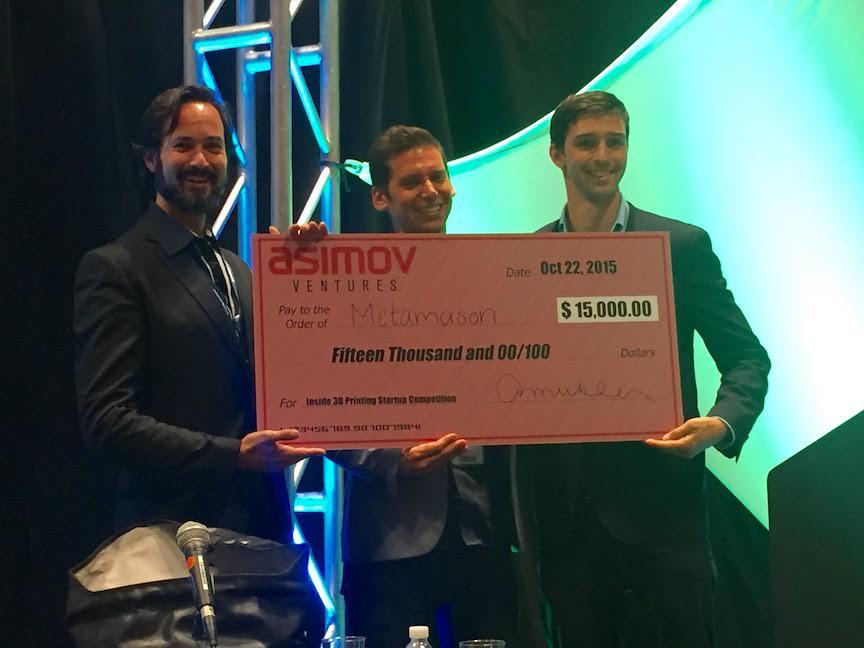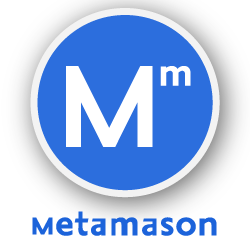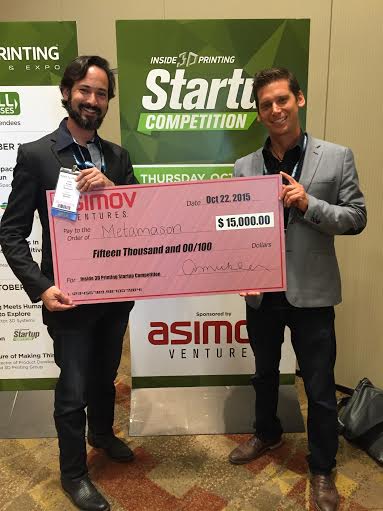 Back in October, at Inside 3D Printing Santa Clara, I sat for the first time in the audience watching the famed Startup Competition shape up in person. I’d been reading a lot about the Competition–which, by the by, is currently accepting applications for the next take, the newly-renamed Frontier Tech Showdown, at Inside 3D Printing New York next month–and watching the candidate companies present on their impressive business schemes was truly a breath of fresh air in the crowded convention hall. That autumn day, seven companies presented their pitches, each taking a very different approach to high-tech solutions.
Back in October, at Inside 3D Printing Santa Clara, I sat for the first time in the audience watching the famed Startup Competition shape up in person. I’d been reading a lot about the Competition–which, by the by, is currently accepting applications for the next take, the newly-renamed Frontier Tech Showdown, at Inside 3D Printing New York next month–and watching the candidate companies present on their impressive business schemes was truly a breath of fresh air in the crowded convention hall. That autumn day, seven companies presented their pitches, each taking a very different approach to high-tech solutions.
In the end, Metamason won the day, coming away with the title as well as a “comically large check” noting that they’d been awarded a $15,000 uncapped convertible note prize courtesy of Asimov Ventures.
Not a team to rest on their laurels, Metamason has been hard at work ever since their big win, using the momentum to continue developing their company and product. As we here at 3DPrint.com love to follow up with what the winners do after triumphs, I recently had the opportunity to ask A Few Questions For Metamason’s Founder and CEO, Leslie (Les) Karpas, who filled me in on the history of and projected future for his company.
When was Metamason founded, and by whom? Where did the idea to form the company come from?
The idea was originally hatched in the spring of 2011, while I was working as a roboticist and CNC machinist for Performance Structures, Inc., a precision steel fabrication firm in Oakland where we were building modern art installations for world-renowned sculptor Anish Kapoor. Creating these large-scale pieces involved the development of CNC robots customized for the topography of individual sculptures; many cycles of 3D-scanning, machining, rescanning and remachining were required to achieve the perfect mirror finishes characteristic of Anish’s work. This formative experience in which scanning, modeling and custom fabrication were integrated to create a unique product triggered a transformation in the way I thought about design.
Around that time, I was at a dinner with two close friends, an ENT specialist and an orthodontist. They were discussing a mutual problem: a mask they couldn’t get their patients to wear regularly, as treatment for obstructive sleep apnea (OSA). My ears perked up—my father had struggled with sleep apnea before his death, and I recalled his complaints about the discomfort and indignity of the ungainly and ill-fitting CPAP mask he has been prescribed. My friends explained that this sort of noncompliance is exceptionally common, and that it often has serious health consequences for patients. In fact, they said, CPAP compliance could potentially save tens of thousands of lives each year, and improve the lives of many thousands more who suffer the ill effects of OSA. Thinking about the process we were using for Anish’s work, as well as my own background in 3D printing, it occurred to me: CPAP noncompliance is a solvable problem. I told them I could make a better mask, and decided to do a little more research on CPAP therapy.
Shortly thereafter, I left my job for Art Center College of Design, to study at the best industrial design program in the country, GradID, with a specific mind towards creating a custom products company focused on CPAP. While at Art Center, I devised Investment Molding™, a technique for 3D printing biocompatible medical grade silicone. When I noticed how rapidly technology was evolving within the 3D printing and scanning space, I knew I couldn’t wait any longer to get Metamason off the ground.
In late 2012, the company officially launched. Backed by the school, Metamason became the first startup funded by The Art Center / Caltech Design Accelerator in the spring of 2013. We began designing and prototyping Respere™, our signature line of custom, scan-to-print CPAP masks. I was able to convince one of my classmates, Ryan Oenning, another expert in 3D printing and smart geometry, to join Metamason as CDO, and recruited the indomitable Charles Bohlen to manage our clinical and regulatory efforts. In the summer of 2015, we recruited Clifford Sarkin, an attorney, dear friend and experienced entrepreneur once responsible for negotiating a startup called VideoSurf’s $80M exit to Microsoft, as Metamason’s CFO/COO.
Along the way, we’ve received tremendous support from the Singularity University community, and have just recently been officially incorporated into the SU Labs program. Additionally, we’d have never made it this far without the wisdom of our advisers, who comprise such notable leaders as Daniel Kraft, Chair of Medicine for SU; 3D-printed fashion designer Francis Bitonti; Andre Wegner, CEO of Authentise; and Kegan Schouwenburg, co-founder and CEO of SOLS.
When did CPAP become the primary focus–was it always meant to be the first goal? (I suppose it’s a chicken or the egg question here–product or company?)
As the product that inspired the creation of our company, the custom fit CPAP mask has always been Metamason’s first goal. However, it was clear from the the beginning that the utility of 3D printing scan-to-fit silicone products would extend far beyond CPAP, which is why we are developing an integrated service platform with a wide array of potential applications. We see ourselves as a scan-to-fit platform-play, with Respere™ as the flagship product line.
How did you begin the development process for the CPAP mask?
Early in the process we had a lot to figure out: What kind of scanners should we use? Is silicone our only option, or are there other possible materials? How can we maximize the reliability and cost-effectiveness of Investment Molding™? They key to answering these questions efficiently was to investigate them all simultaneously, focusing our resources on a season of concerted experimentation across technologies to find the most effective tools and processes.
 How long did the design and prototyping process take?
How long did the design and prototyping process take?
Designing began in late 2012, with our initial prototypes emerging in mid-2013, fabricated with printers that already seem archaic today. It took us 2 years before we reached the first really believable proof of concept. Today, the Respere™ line of custom CPAP masks continues to expand to include new styles, and each prototype is completely original because it incorporates the data of a specific patient’s individual features.
What design software do you use?
We primarily use Rhinoceros and Grasshopper, in conjunction with a variety plugins for both.
What 3D scanning technology do you recommend doctors use?
High accuracy is appealing to everyone, but it is also the single largest factor influencing cost when purchasing a scanner. Going with the lowest accuracy the design tolerates will generally minimize the cost of the 3D scanner. We have found that 300 microns of accuracy is the minimum threshold for our use case, so we recommend scanners that scale up from there. At the moment we’re big fans of the Occipital Structure Sensor, and enthusiastically anticipate the next generation of Intel’s RealSense technology.
What led you to 3D technology?
When I was 12 years old, Intel had just released the first Pentium processors. Everyone was in awe of how fast they were. My stepdad bought me a computer and told me that if I could “push it into the red”—I remember him using those words— he would buy me a better one that I couldn’t. He underestimated just how motivating that carrot would be! Naturally, I dedicated myself to figuring out how to push a computer as hard as possible, occupying its processing bandwidth with so much information that it would grind to a blue-screened halt and I would get a newer and better computer. At the time, this meant 3D modeling. I started by modeling imaginary environments with a level creator for a popular video game called QuakeWorld. By the time I got to high school I was a 3D modeling wunderkind, and began interning for architecture firms. Then, in 1999, I met my first 3D printer, an early Dimension FDM machine. The rest is history.
 What sorts of 3D printing hardware do you use?
What sorts of 3D printing hardware do you use?
We’ve been quite fortunate in developing R&D partnerships with 3D Systems, EOS, and Carbon3D. 3D Systems is helping us perfect Investment Molding™, and we’re collaborating with EOS to develop something we’re calling ‘Hydrostatic Molding. Carbon3D is working with us to make high-quality, affordable, direct printable masks.
You use soft, biocompatible silicone materials–who supplies them?
In our Investment Molding™ process, we use platinum-cure medical grade silicone. Bluestar Silicones has been very helpful in working with us to find the right formulation.
What was your team’s reaction to winning the Startup Competition?
We were elated. We have a great deal of respect for the other competitors and thought they all brought very strong offerings to bear. It seemed like a tight race—although when one of the judges mentioned that he suffered from sleep apnea and very much wanted a Respere™ mask, we thought that was a pretty good sign!
Now we’re gearing up for SXSW Interactive, where we’ve been nominated for an Interactive Innovation Award in the Innovative 3-DIY category, “awarded for making 3D printing technology more accessible or affordable, or to the Maker using such technology in new and exciting ways.” We’re humbled to be in the company of our impressive fellow nominees, including Formlabs, Utilimaker, Proto BuildBar, and Wevolver.
What does the Metamason timeline look like?
We’ll be engaged in continued R&D, clinical trials, and FDA regulatory tests until Q1 of 2017, which is when we plan to publically launch Respere™. In the meantime,we’re gearing up for an Indiegogo campaign this summer, where we’ll raise funds by preselling our masks. To learn more about the campaign and to follow Metamason’s progress, visit our website or like us on Facebook at www.facebook.com/metamason3d.
The future certainly continues to look bright for Metamason–and those in need of CPAP machines and comfortable masks!
Is your company interested in being the next success story? Apply now for the April Frontier Tech Showdown, which will take place April 12th from 11:45 am to 12:45 pm, and don’t forget to register to attend at Inside 3D Printing New York (and remember, 3DPrint.com readers can save 10% on registration by using discount code ‘3DPRINT’). We’ll see you there!
Subscribe to Our Email Newsletter
Stay up-to-date on all the latest news from the 3D printing industry and receive information and offers from third party vendors.
You May Also Like
3D Printing News Briefs, April 13, 2024: Robotics, Orthotics, & Hypersonics
In 3D Printing News Briefs today, we’re focusing first on robotics, as Carnegie Mellon University’s new Robotics Innovation Center will house several community outreach programs, and Ugogo3D is now working...
Rail Giant Alstom Saves $15M with 3D Printing Automation Software 3D Spark
3D Spark has entered into a three-year deal with the rail giant Alstom. Alstom, a transport behemoth with annual revenues of $16 billion, specializes in the manufacture of trains, trams,...
Meltio Expands Global Reach with New Partnerships in the Americas and Europe
Spanish 3D printing manufacturer Meltio has expanded its sales network across the globe. With the addition of three new partners in the United States, Brazil, Argentina, and Italy, Meltio aims...
3D Printing Webinar and Event Roundup: April 7, 2024
Webinars and events in the 3D printing industry are picking back up this week! Sea-Air-Space is coming to Maryland, and SAE International is sponsoring a 3D Systems webinar about 3D...































